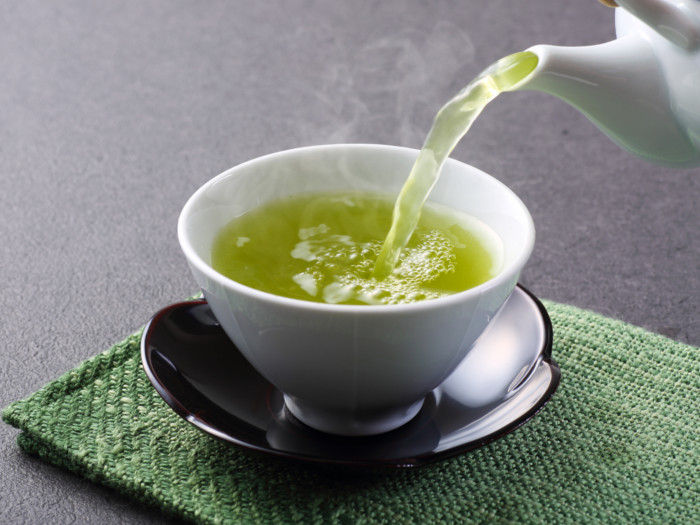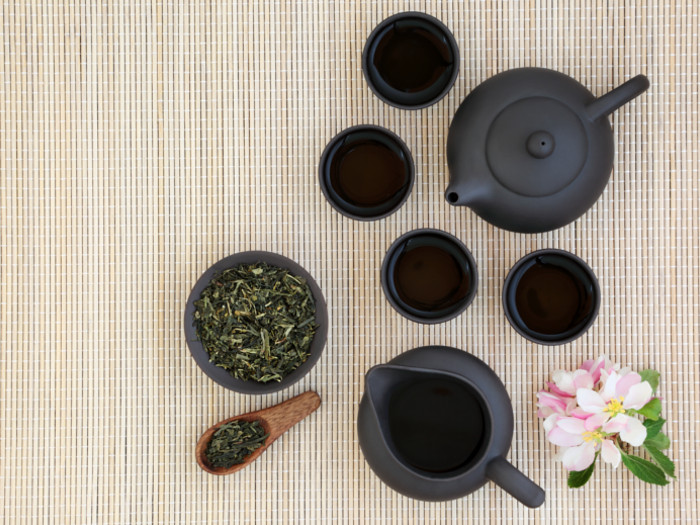Over the years, people across the world have bestowed green tea with a coveted position as a miracle drink for healthy skin and hair, weight management, and an immunity booster among several other health benefits. For the Japanese, green tea is more than a way of life – one that goes beyond the general etiquette of hospitality. The beverage is so synonymous with their culture that the Japanese green tea has come to form a rich and varied world in itself, holding an increasing amount of interest and fascination for tea enthusiasts across the globe. [1]
What is Japanese Tea?
There are over 20 different Japanese teas. The majority of tea consumed in Japan is green tea. Unlike the usual green teas that you see, Japanese green tea leaves are thin, razor-sharp, and pointed and are dark green in color. Most Japanese teas, unlike Chinese teas, are produced by steaming and not through drier heats such as pan-frying. Steaming helps to prevent oxidation, which aids in keeping the color and fragrance fresh and also the nutritional value of the tea intact.
Japanese green teas are quite well known. The teas that are made quite often in Japan are the steamed type of sencha and fukamushicha teas. The other two types of teas that are very popular and closely follow suit are the aromatic bancha and hojicha teas. Matcha, on the other hand, has become quite a popular drink all over the world and so have genmaicha and hojicha. What are these teas and what is their history? Let us find out.

Japanese green tea is an ideal addition to a weight loss diet. Photo Credit: Shutterstock
History of Japanese Tea
The concept of tea was introduced in Japan by the Chinese. According to folklore, it was a Buddhist monk, Saisho, who brought tea leaves from China to Japan during the Heian period (794 AD-1185 AD). However, the country was truly introduced to its tea culture only in the eleventh century when a monk named Eisai brought back tea-tree seeds from China. Buddhist monks used it as a stimulant to prevent drowsiness during meditation. [2]
Sometime around the 16th century, the Japanese came up with a technique to shade the tea plants from the sunlight using tana canopies, which is still used to grow matcha and gyokuro teas. It was around the 17th century when Chinese monks made the shift from powdered tea to infusion tea and introduced the same in Japan. However, Japan was forced to come up with and embrace its own tea culture only between 1641 and 1853 when the country embraced the infamous isolation policy, cutting all ties with its neighboring countries, particularly China.
In the 18th century, Soen Nagatani, who is known as the inventor of the most popular Japanese tea sencha, devised the steaming method to prepare tea. This method is being used to make tea even today without compromising the freshness of the tea leaves. Over the next few centuries, the concept of tea drinking only continued to grow. Today, it has become an intrinsic part of the Japanese culture with all the levels of society adopting it as the central part of their daily lives. [3]
Etiquette and Culture
Green tea is so popular in Japan that a day is dedicated to being celebrated as the Green Tea Day in the country. It falls on the 88th day after the first day of spring, which is also known as Risshun, in Japan. This means that the day usually either falls on May 1 or 2 every year. Given that morning frost can damage tea leaves, it is ideal to harvest the leaves once the weather begins to warm up. Perhaps that is why the 88th day from Risshun is considered as the perfect time to start harvesting the tea leaves. The day also stands for the reverence the nation has towards this healthy, aromatic, and piquant beverage.
Tea has always been an integral part of Japanese culture. Consumed several times during the day, it is the most preferred drink to have first thing in the morning as well as after meals. Most restaurants in Japan serve tea after every meal for free. Additionally, serving tea to the guests is considered as a mark of hospitality in the country, much like other Asian countries. This beverage has a very important place in the common man’s life in Japan. It is not only had casually but also served in many formal gatherings and occasions. The Japanese also have a dedicated tea ceremony, which is a proper discipline in itself taught in different schools.
What is the Japanese Tea Ceremony?
In Japan, the tea ceremony is called Sado, Ocha or Chanoyu. In English, the tea ceremony is referred to as the Way of Tea, which is an important ritual dealing with the preparation and serving of tea. It is quite a strict protocol. In Japan, serving tea is an art and a spiritual discipline. The entire process has got less to do with drinking tea, but more to do with the aesthetics involved in making and serving tea. Right from the placement of the tea utensils, the flower arrangements, to the ceramics, and calligraphy – the host of the ceremony plans everything keeping the comfort of the guests in mind. [4]
There are two different kinds of Japanese tea gatherings related to this ceremony – chakai (informal) and chaji (formal gathering). These two differ from one another in their protocol, complexity, and time span. The type of tea that is usually used in this ceremony is powdered green tea, commonly known as matcha. Another lesser-known ceremony, known as senchado, makes use of tea leaves instead of powdered tea.

Sencha tea has an astringent flavor. Photo Credit: Shutterstock
Types of Japanese Tea
Japanese teas have a wide range of possibilities as far as their taste, texture, and aroma are concerned. If you want your tea to be astringent or smooth, you have a plethora of options to choose from. Let us take a look at the different types of Japanese teas.
Gyokuro: Gyokuro is the highest grade of Japanese green tea and also very expensive. It is kept away from sunlight for three weeks before it is harvested. It directly translates to “jade dew”. Given that it is grown away from direct sunlight, the theanine content in the tea, which is a form of amino acid, elevates to give the tea a naturally sweet and ‘umami’ flavor. While you can make a hot version of this green tea, it tastes better when you make a cold iced tea out of it. [5]
Sencha: Sencha constitutes 80% of tea production in the country. According to Patricia Jane Graham’s book, Tea of the Sages: The Art of Sencha, it is quite astringent in its flavor as it has a high percentage of tannin compared to other teas. It also acts as the perfect palate cleanser before and after meals. Sencha, unlike gyokuro, grows in direct sunlight and the leaves are picked between February and May. [6]
Fukamushicha: Fukamushicha tea is a stronger tea with a powerful aroma. It is light on the stomach and is good for digestion. To make this tea, the leaves are steamed for a longer duration so as to extract its natural flavors. The color of the tea is dark green. While the fragrance is quite deep and rich, its taste is naturally sweet and moderate.
Konacha: Konacha tea is also known as agari tea and is usually served with sushi in restaurants. It is a form of powdered tea. The tea dust that is obtained after processing sencha and gyokuro tea is what comprises Konacha tea. Due to its strong, rich flavor and color, it is used as a perfect cooking ingredient. [7]
Kukicha: The stems and stalks discarded during the production of sencha and gyokuro teas are used to make kukicha tea. The taste is clean and it has a light as well as smooth flavor and texture. It is also quite highly-priced.
Matcha: Matcha tea is a form of powdered tea that is used in Japan’s formal tea ceremony. The highest quality of matcha tea is of a darker shade of green. The lighter the shade of the tea means the sweeter the taste. On the other hand, the darker the shade, the more astringent the taste. The unpowdered form of this tea is known as tencha. Matcha is an important ingredient in all savory and sweet dishes. [8]
Bancha: Bancha is less fragrant and more astringent in flavor. Perhaps, that is why it is the perfect tea to sip after a heavy meal. It is the perfect concoction to have for tooth decay. Once the picking of sencha tea leaves is done between February and May, fresh and new shoots and buds begin to grow, which are used to make bancha tea. Apart from this, larger leaves and upper stems that are discarded in the process of sencha tea production are used to make bancha tea. [9]
Genmaicha: Genmaicha tea goes perfectly well with deep-fried food items. It is made by amalgamating medium-grade sencha tea or bancha tea with well-roasted brown rice. Brown rice is known as genmai in Japanese, from which the name genmaicha is derived. Brown rice adds a nutty flavor to the tea. [10]
Hojicha: If you roast bancha or sencha tea leaves over high heat, you get brownish tea leaves with a savory taste. Owing to its low caffeine content, it can be given to kids. [11]
